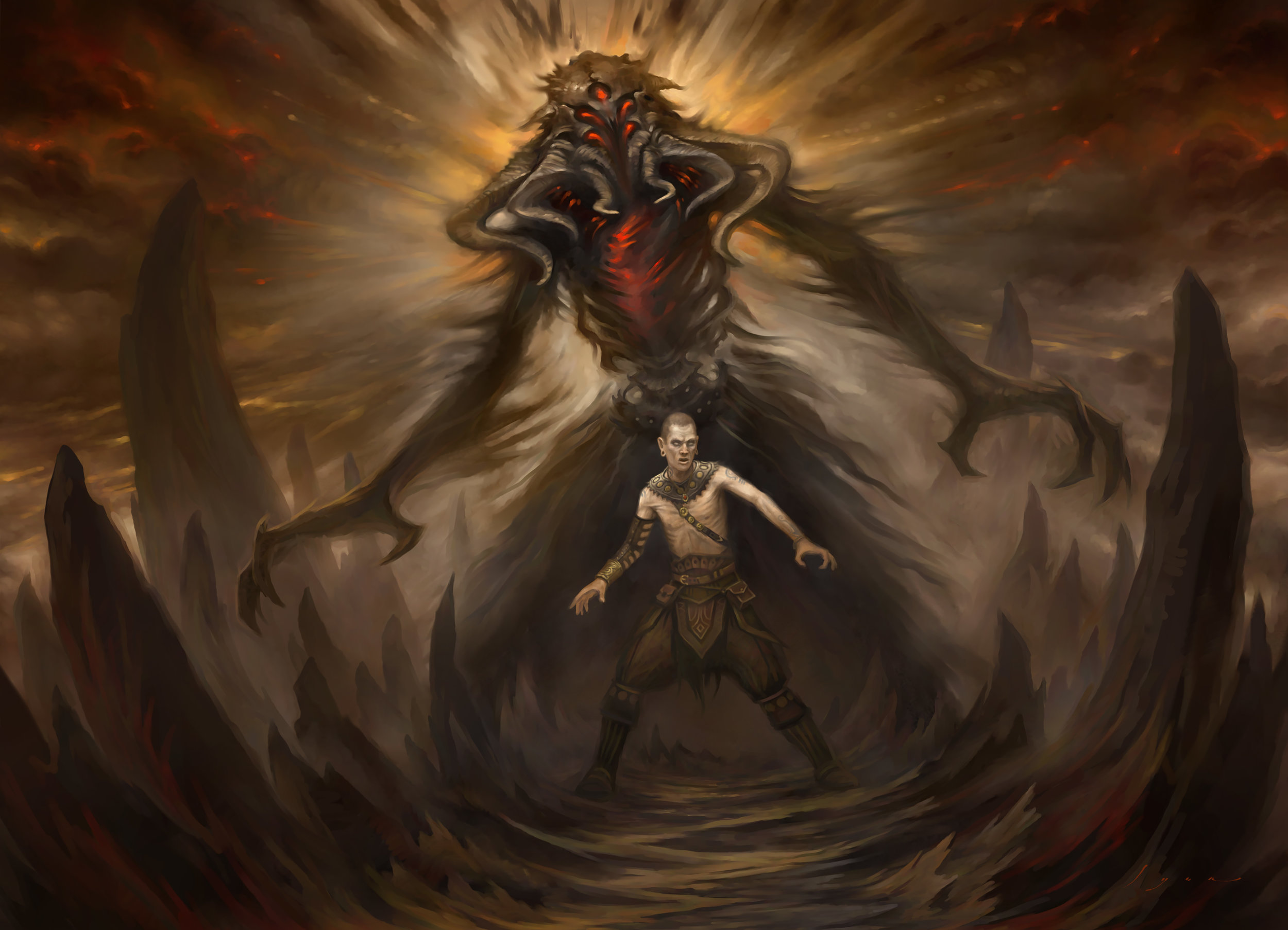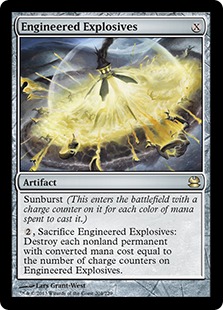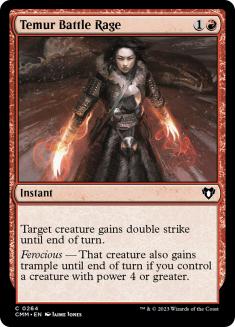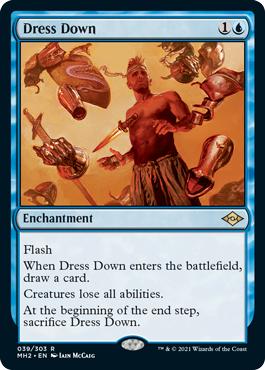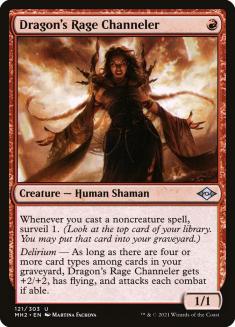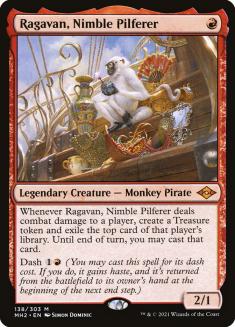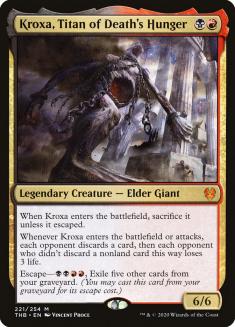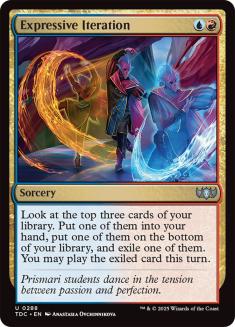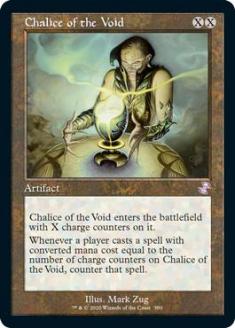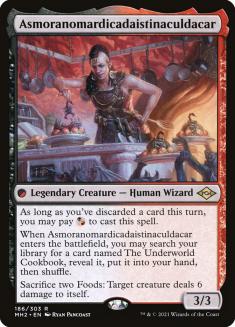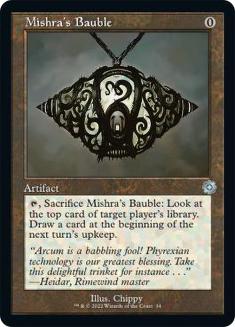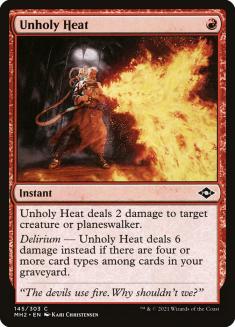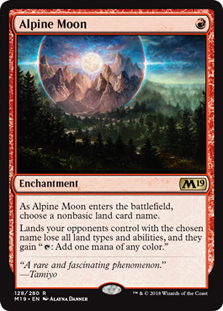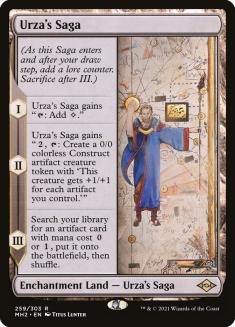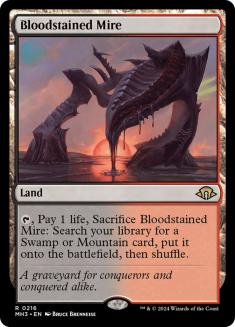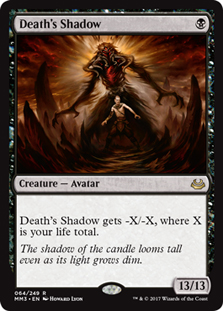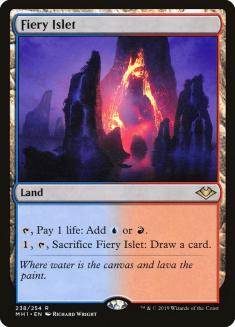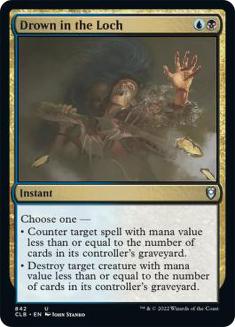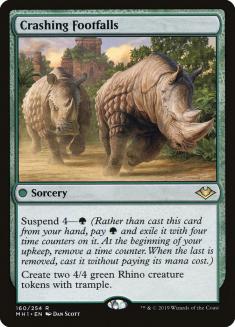The Modern format is in flux with a few key players hovering around the top. Everyone is vying for interesting technology to give them a leg up on the competition, but there’s a major problem with that mentality: you can’t maindeck hate cards without sacrificing deck integrity. The key is finding spells or lands that can fit the mold of your archetype while having utility in a given matchup. Sometimes there’s an intersection between “highly played card” and “putting the most popular deck into the dumpster” but those times are rare.
New cards that offer unique play patterns will regularly create vacuums for old cards to step up and challenge them. We’ve seen this recently with Engineered Explosives, which has seen a resurgence in play thanks to the popularity of Urza’s Saga and Crashing Footfalls. Having a cheap way to deal with the tokens is cool, but what’s even cooler is that Engineered Explosives is also a great Magic card on its own. When those two factors collide, old cards that have been somewhat forgotten gain new life.
Modern problems require complex answers. On occasion, that complex answer comes in the form of a new card that people initially discarded. Today’s article will focus on Grixis Death’s Shadow (Lurrus) in Modern, and how it has begun to incorporate a new card from Modern Horizons 2 as both a defense mechanism and an aggressive tool.
Rebuilding Grixis Death’s Shadow from the Ground Up
When I say the name “Grixis Death’s Shadow,” my first thought is the older version featuring Snapcaster Mage and Gurmag Angler. I have fond memories of that version, as it contains all the different types of Magic I like to play and just so happened to give me my last major finish before moving to full-time commentary. Nowadays, Grixis Death’s Shadow is an entirely different animal. It went through significant changes with the incorporation of Lurrus of the Dream-Den, and for good reason. The card is absolutely busted and you should be actively working to build your deck around it if possible.
Old versions of Grixis Death’s Shadow were Dimir in nature with a light splash for Kolaghan’s Command. Since Snapcaster Mage helped grind out longer games, Kolaghan’s Command was a natural tool to incorporate. Lurrus takes away some of that pressure to go long because it singlehandedly allows you to keep playing when you’ve run out of resources, but we’ve been gifted new threats that require us to rethink the nature of our deck.
When Modern was a more combo-heavy format, Temur Battle Rage could steal games you had no business winning. Alongside Scourge of the Skyclaves and Death’s Shadow, Temur Battle Rage was a knockout blow for any deck that wasn’t necessarily interactive. However, the more interactive the format becomes, the worse a card like Temur Battle Rage is. As someone who played a lot of Infect, I know how fragile a strategy can be when you’re relying on combining creatures with pump effects.
People have been building Death’s Shadow in the same ways they always have. Temur Battle Rage is fine when your creatures are Gurmag Angler, Death’s Shadow, and Tarmogoyf. It’s much worse when your creatures include Ragavan, Nimble Pilferer and Dragon’s Rage Channeler (DRC). With that said, I do believe we’ve moved into a new era where Death’s Shadow can just be a cheap creature we pair with interaction instead of a creature we need to combo-kill with. Both Ragavan and DRC lend themselves to Rakdos builds that feature cheap removal and discard. That sounds a lot like the type of deck where Death’s Shadow would thrive, right?
So let’s go ahead and talk about the new card that Death’s Shadow is using to great effect as both a defensive measure and a potentially explosive tool for dealing bursts of damage.
Dress Down is a strange card. I first saw people talking about it with Phyrexian Dreadnought in Legacy, but my initial reaction to this card when it was first previewed was “meh.” It was interesting, but probably just a sideboard card to help out against weird creature-based decks. As a one-shot way to stop effects of creatures entering the battlefield, it served a specific purpose for blue decks to fight against Primeval Titan and the like.
What I learned recently shocked me, and made me rethink every interaction that this card could potentially produce: Dress Down kills the Construct tokens from Urza’s Saga. That alone is worth the price of admission, but Dress Down does a lot more than that. Elementals has been on the rise recently, and nearly all of their creatures have abilities that trigger when they enter the battlefield. They also build upon each other, which means a single Dress Down can stall out multiple sources of advantage for a turn, giving you precious time to close the game with burn spells or contain the creatures your opponent has on the battlefield.
That’s two uses. Third time pays for all.
Dress Down turns off Death’s Shadow, meaning it will be attacking as a 13/13 whenever you need it to. Sounds a lot like Temur Battle Rage, right? It is rare that we replace a fragile spell with one that can replace itself, but that’s exactly what we’ve done. Dress Down looks weird on paper, but I have seen it do some absolutely disgusting things in the short period of time that I’ve been playing with it. Big shoutout to Aspiringspike for showcasing this technology to the world. He’s done a lot of work recently on Grixis Death’s Shadow with Dress Down, and the lists I’ve started at all came from him.
Dress Down isn’t just some hate card. It replaces itself while doing that hateful thing, which is basically the difference between Autumn’s Veil and Veil of Summer. While the effect that Dress Down has on the game isn’t as intense as Veil of Summer’s, a hate card at your disposal that replaces itself means you can maindeck it. When your deck can take advantage of the hate card in question, like making Death’s Shadow a 13/13, you have yourself a real winner.
Now that we’ve let the cat out of the bag, let’s take a look at the list.
Creatures (15)
Lands (19)
Spells (26)

The new creature core for red decks has a lot of crossover play in Death’s Shadow. These two creatures shine in a deck that’s interactive. Discard spells protect them from removal. Removal spells of our own can clear blockers so we can connect with Ragavan.
DRC thrives when you play a ton of cheap spells. Even without Ragavan, I would be inclined to play DRC is any Death’s Shadow deck because they both work well with the same interactive suite. Ragavan plays similarly well with all the interaction, and is generally more welcome in a Death’s Shadow style of deck than something like Burn. The damage output of Ragavan isn’t exactly outrageous, which is why we want it in a deck that can take advantage of the extra mana or extra card from the opponent.
We’ll be seeing this duo for a long time to come. They’re two of the best creatures in Modern, and work very well in interactive strategies. While they don’t pack the same punch as Goblin Guide or Monastery Swiftspear, they’re both excellent in archetypes that are trying to dictate the pace of the game. Goblin Guide and Monastery Swiftspear contain a fire that burns wild. DRC and Ragavan are more of a controlled burn. Death’s Shadow plays much better in the latter.
Kroxa, Titan of Death’s Hunger doesn’t exactly scream “aggro,” but it has found a home in nearly every Rakdos core featuring DRC. Having that freebie mill over it is bonkers, but just fueling Kroxa by putting a bunch of useless discard or lands into your graveyard makes casting it via escape much faster. As I said earlier, the games tend to go much longer these days, so having a threat that offers functionality both early and late in the game means you’ll usually have something to do with your mana. Cards that offer that type of flexibility are the lifeblood of a deck like this. We want most of our spells to be modal in some fashion because that allows us to pick and choose the best spots to get the most out of them.
Kroxa is also one of the more disgusting midrange threats. Like Uro, Titan of Nature’s Wrath, that escape clause makes it a powerful threat in the later turns of the game because a single removal spell won’t do the trick. You have to keep killing it over and over or else it threatens to attack for huge chunks of damage. Every time it shows up, you also get to make your opponent discard and potentially deal them some extra damage.
In a deck that has all these grindy elements, the odds that your opponent is able to continuously keep extra cards in hand is low. Kroxa gives you a threat with similar closing speed to Death’s Shadow but without the vulnerability to spot removal. It’s slow, but that’s okay; we’re much slower on average than our Death’s Shadow ancestors. The days of Become Immense into Temur Battle Rage are long gone. Let us thrive in this new, more interactive world with threats designed to punish those who choose to interact.
My article from last week focused on this card’s profound impact on virtually every format where it’s legal. Expressive Iteration is one of the best card advantage spells ever printed, seamlessly interweaving card selection into the mix. For two mana, it’s hard to ask for better. If we’re looking to move Death’s Shadow from the realm of creature-combo to a more grindy version, Expressive Iteration has to be an auto-include.
The trick to using Expressive Iteration in a Death’s Shadow deck is making sure all your spells are modal. That means Lightning Bolt over Fatal Push. That means Drown in the Loch over Counterspell. We need to make sure every Expressive Iteration is an absolute banger. As the game goes long, a card like Expressive Iteration will almost always be the best draw possible. If we have too many reactive or dead cards, that won’t be the case.
Discard spells have diminishing returns, and are relatively weak when games go long. Thoughtseize is automatic because it helps push you toward casting Death’s Shadow, but I’m not even sure Inquisition of Kozilek is even warranted anymore. I’ve seen plenty of black decks moving away from discard in favor of more removal. This is mostly due to the lack of combo decks in the format. Discard effects are fine against everyone, but usually shine against decks that need two or more specific pieces to work. Against control, taking their interaction is key. Against aggro, taking some of their more explosive elements helps you contain their threats. However, as more interactive decks enter the fray, discard is worse because the games go longer.
Have you ever drawn an Inquisition of Kozilek when staring down the barrel of a Tarmogoyf? It doesn’t feel good.
Common Occurrences and Corner Cases
Modern is full of surprises. Having a card that breaks the rules of the game like Dress Down can offer some unique experiences, or completely alter how we interact with specific cards or decks.
If you’re so inclined, feel free to cast Dress Down on your opponent’s end step. Then, on your own turn, the Dress Down will still be on the battlefield, so you can cast Kroxa from hand and it’ll stick around. Of course, you won’t get the discard trigger, but that’s okay. A huge body that threatens to deal massive damage and force your opponent to discard cards every attack step is pretty solid, I heard.
If you have Lurrus on the battlefield, you can only cast spells from your graveyard on your own turn. However, you can cast Dress Down during your own end step so you gain its effect during your opponent’s whole turn. It’s a way for you to continuously interact with your opponent’s creatures, turning them off while drawing cards all the while.
Lurrus has a clause that says you can’t cast spells from the graveyard with a mana value of three or greater. X-spells don’t get around this, as we discovered with Walking Ballista in Vintage when Lurrus was first printed. That means we can only cast Engineered Explosives for X=2 or less with Lurrus. That shouldn’t be a big deal, but you should understand this interaction before picking up the deck. Engineered Explosives can be cast from the graveyard for X=0, which is great for containing Crashing Footfalls or Urza’s Saga, and will be one of the more common play patterns.
Asmor is vulnerable to both Chalice of the Void and Engineered Explosives for X=0. Keep that in mind if you come up against it, as Asmor is the core that their deck revolves around. While Chalice of the Void is primarily for cascade decks, it has utility in a number of matchups.
Expressive Iteration is best when cast later in the game, but there are a lot of scenarios where you might want to cast Expressive Iteration on the second turn. While you usually want to hit a land off the exiled card, any zero-mana spell is also fine. If your opponent is playing a combo deck where an X=0 Chalice of the Void is needed, casting that dig spell on the second turn to look for it could be the difference in winning or losing the game. Even if you miss, you can still cast Mishra’s Bauble if you find it. While casting Expressive Iteration on the second turn is rarely correct, I don’t want any unshakable rules. Make sure you give yourself the best chance to win at all times.
DRC has to attack if you have delirium, which can occasionally be awkward against creatures with flying or reach. Dress Down can take away that ability for a turn, giving you more time to find a way to clear that blocker. It doesn’t happen often, but knowing how your spells interact is crucial to playing a deck like this.
Because DRC lets you put cards into the graveyard at instant speed, you can occasionally gamble with stuff like Unholy Heat when you don’t have delirium in the hopes that you hit delirium on the surveil. In general, you want to leverage the surveil from DRC to turn on delirium for both DRC and Unholy Heat. Just remember you can cast Unholy Heat without delirium and still get the six-damage effect if you hit delirium before the spell resolves.
Dress Down is nice for turning off creatures’ abilities, but you need to be careful on occasion. If your opponent uses the evoke cost of Endurance or Solitude, or any of the other Elemental Incarnations, that creature will stick to the battlefield and not die during the end step. Try to gauge whether the effect it creates or the body it will provide is worth more, and choose when to cast Dress Down accordingly.
If you haven’t heard by now, all “Moon” effects outright kill Urza’s Saga. It’s a weird interaction, but the short version is that “a Saga without chapters goes to the graveyard.” I haven’t been a big fan of Alpine Moon, but this specific interaction makes it worthwhile. Hate cards for lands are few and far between. The fact that Alpine Moon only costs one mana and hammers Urza’s Saga is huge for combating those decks. We must fight them on a fair basis, which means we need cards that offer horrific outcomes for them.
I’ve noticed that a lot of newer players aren’t exactly keen on how to best use Mishra’s Bauble. Looking at your opponent’s top card is great for gaining information on what to take with Thoughtseize, but using it on yourself is also important for smoothing out your draw. If you have multiple lands in hand, targeting yourself and seeing a land on top means you can choose to play a Bloodstained Mire and shuffle that extra land away. That means drawing a fresh card. For those who are seasoned with Mishra’s Bauble this might seem obvious, but it’s an important interaction to know and understand if you’re going to play a deck like this. You need to know how to get the most out of all of your cards.
Lightning Bolt will usually go for the opponent’s creatures or their head, but did you know you can target yourself? On occasion, you will get stranded with a Death’s Shadow in hand with thirteen or more life. This is problematic for newer versions of Death’s Shadow specifically because we don’t play Street Wraith. There may be times where you need to Lightning Bolt yourself just so you can get Death’s Shadow onto the battlefield.
Having a land that can deal you damage every turn over time can help you manage your life total for Death’s Shadow. If you’re above thirteen or already have Death’s Shadow on the battlefield, it will likely be correct to keep dealing yourself one point of damage every turn.
Normally Drown in the Loch is pretty terrible when your opponent doesn’t have a graveyard, but having zero cards still means having a number. Drown in the Loch can always counter a spell with zero mana value and destroy any token creature. With that said, a spell like Chalice of the Void or Engineered Explosives will have the casting cost of whatever mana is paid into it when it’s on the stack, so Drown in the Loch won’t affect them unless the graveyard is of adequate size.
Winning by Inches
Decks like Death’s Shadow often operate with extremely thin margins. Some mistakes are so detrimental that they end the game on the spot. Other mistakes aren’t as easy to spot, yet can cascade into situations where they will either directly or indirectly cost you the game. When you’re playing a slower deck featuring a ton of interaction, you need to understand how to gain the most out of every card. On occasion, it takes squeezing the juice out of every last Ragavan to win. That’s just the cost of doing business. If you want easy wins, go play Mono-Green Tron.
As formats get bigger, more cards can interact, which leads to some really messed-up stuff inside the game’s engine. The more you know about your deck and its role inside that format, the better off you’ll be when facing unknown enemies. Unlike Standard, the Modern format doesn’t quickly or easily become solved. As a result, you need to be prepared to beat just about everything. Intimate knowledge of your deck and the format as a whole helps in that preparation. Leveraging that knowledge is how you gain an advantage in deckbuilding, sideboarding, and the actual games.
The draw for decks like Death’s Shadow is that they aren’t particularly exploitable. Death’s Shadow can occasionally lose to Burn because they deal themselves too much damage, but that isn’t an easy hole to poke, and it requires a specific archetype as opposed to a specific hate card. We move like water across the rocks. We glide with ease and take the role that’s given to us by what our opponent is playing. We’re flexible, and we strike hard and fast when the time calls for it. But we can also be smooth and serene and patient when we need to be.
I adore strategies like Death’s Shadow because they offer a type of gameplay that I enjoy more than any other. I like applying little bits of pressure and packing the slightest amount of disruption to trip the opponent up. And I like drawing cards and killing creatures. I like everything about this deck down to its bones. Dress Down is just another addition to an archetype that has been successful for years. It’s weird, but I think you’ll be pleasantly surprised by just how good it can be, in both defensive and aggressive roles.
If you’re an old-school Death’s Shadow aficionado, or just want something new to take for a spin, I highly recommend this version of Grixis Death’s Shadow (Lurrus).

